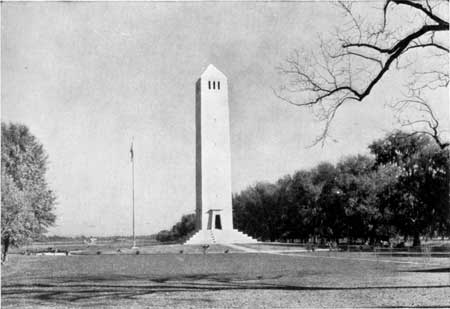MENU
|
Glimpses of Historical Areas East of the Mississippi River |
|
The Early Republic |
|
LOUISIANA |
Special Feature: Part of the ground on which the Battle of New Orleans was fought January 8, 1815.

Chalmette Monument.
(Photo by Grant)
CHALMETTE NATIONAL BATTLEFIELD SITE, located 7 miles below New Orleans, embraces part of the ground made historic by the brilliant defense of New Orleans by the American forces under Andrew Jackson against the British on January 8, 1815.
After its unsuccessful assault on Fort McHenry during the War of 1812, the British Army reembarked and dropped down Chesapeake Bay and late in October sailed for Louisiana, intending to seize New Orleans and the mouth of the Mississippi River. Strengthened by the addition of several veteran regiments waiting in the West Indies, the British expedition consisted of 50 ships and about 9,000 men when it reached the Gulf coast.
On December 23, transported across Lake Borgne and up the Bayou Bienvenu, the advance guard effected a landing and arrived at the Villeré plantation, 8 miles below the city, capturing that household. New Orleans lay before the British unprotected. But their commander was cautious, waiting for the main body of troops and supplies to arrive before beginning the attack. Major Villeré, however, had escaped the British and warned Jackson of their coming. As the great bell of the cathedral rang the alarm, regulars, militia from the interior, and Creole natives of New Orleans, as well as Negroes, Dominicans, and pirates, poured into the Place d'Armes from all quarters of the city. General Jackson, commanding the American troops, had time to construct defenses against his opponent's artillery and to bring together an army of about 6,000 men. Behind Jackson's fortifications was gathered as motley an array of men as ever at one time fought under one banner—the Mississippi Dragoons scouted about; hardy Kentuckians rubbed shoulders with gayly dressed Creoles; the Louisiana militia fought side by side with the pirates of Barataria, under their leader Jean Lafitte; a battalion of Dominicans served besides groups of Tennesseans and free Negroes.
On January 8, 1815, after preliminary skirmishes, Sir Edward Pakenham, the British commander, finally ordered an attack on the American entrenchments, confident that the militia would flee when charged by his veterans. The principal assault took place on the eastern bank of the river, the British advancing at dawn, only to be met by a furious rifle fire. Pakenham and two of his generals soon fell. The total loss in this part of the attacking force was 1,971 killed and wounded, compared with but 13 on Jackson's side. Within less than 2 hours the British were so demoralized that they retired from the field. Meanwhile, on the western bank the battle was going against the Americans, but so overwhelming was their victory on the opposite shore that the British commander recalled his entire force from the field. An armistice was concluded and the day was spent in gathering the dead, who were buried at night by torchlight. After a few days the British Army sailed away, abandoning the campaign. Never since has there been armed conflict between the United States and Great Britain.
The victory at New Orleans was an outstanding event in American history. It saved the city from conquest and sack, and restored the people's confidence in their military prowess. Above all, it was a victory of the pioneer. Throughout the West, Andrew Jackson became in the eyes of the people the greatest living American. To this popularity was due in considerable measure his elevation to the Presidency in 1828.
The grateful people of New Orleans built two memorials to their hero. Both cornerstones were laid on January 9, 1840. Jackson, who was visiting the city, participated in the ceremony held at the Place d'Armes.
Development of this area as an historical reservation began in 1840 and was continued by the State of Louisiana and the Louisiana branch of the National Society of the Daughters of 1812 who took a prominent part in the erection of an attractive memorial similar in design to the Washington Monument. Declared a national reservation in 1907, it was under the jurisdiction of the War Department until transferred to the Department of the Interior in August 1933.
NEXT> New Echota Marker National Memorial
 Top
Top
Last Modified: Tues, Nov 28 2000 10:00:00 pm PDT
http://www.cr.nps.gov/history/online_books/glimpses3/glimpses3e.htm
![]()
